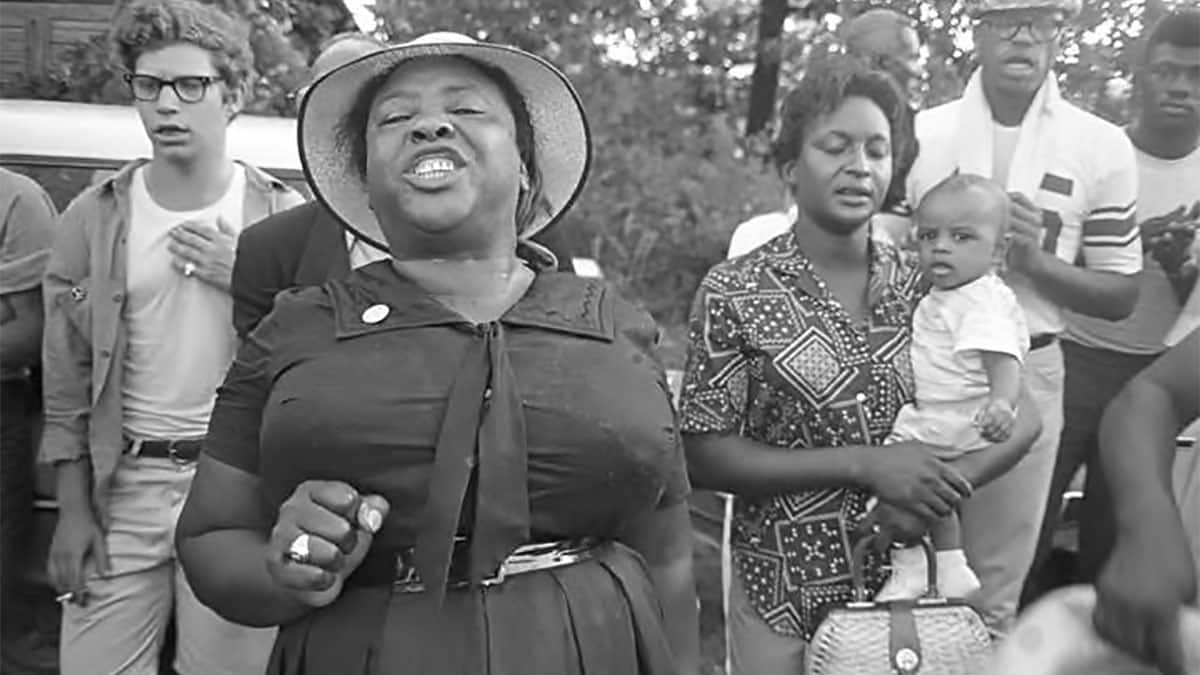Mississippi Today
Remembering Fannie Lou Hamer: Monica Land pays tribute to her aunt

Editor’s note: This article was written by Monica Land, niece of the famed civil rights leader Fannie Lou Hamer. It first published in The Enterprise-Tocsin newspaper on June 21, 2024, and is republished below with permission. Click here to read the story on The Enterpise-Tocsin’s website.
Everything I know about Fannie Lou Hamer, I learned from someone else. And that will forever haunt me as a tremendous loss of opportunity considering that she was my great-aunt.
Growing up, I often heard my family speak of her as an almost mythical figure. A woman, who not only prayed for change, but vowed herself to bring it. They’d laugh when they recalled the funny things she said or did. But their faces turned somber, cold and sad when they remembered the pain and sufferings she endured.
As a youngster from Chicago, I recall visiting my Uncle Pap and Aunt Fannie Lou during the summer. When we walked into their Ruleville home, I remember she was always lying down or sitting. As was customary, I spoke and gave her a hug, but then off I went to play with her two daughters, Cookie (Jacqueline) and Nook (Lenora).
It was the 1970s, and I deeply regret that I was too young to know that I should have stayed and talked to her, listened to her and asked her questions. As a teenager, I regret not asking my Uncle Pap or my maternal grandparents — who were very close to her — questions about her life and her childhood. And now those opportunities are gone.
As a writer and an aspiring filmmaker, I was determined to learn more about her life and to tell her story, and it took me more than 15 years to do it.
That film, Fannie Lou Hamer’s America, allows audiences to see and hear a side of Aunt Fannie Lou that many never have before. In fact, during the research phase of that project, I learned things myself that I had never known. Things that both surprised and horrified me.
Aunt Fannie Lou was an exceptional person. While many remember her as a fierce proponent of voting rights, who was “sick and tired of being sick and tired,” Aunt Fannie Lou did so much more, providing food, clothing, housing, educational opportunities and even jobs for the marginalized residents of the Mississippi Delta, while she herself had nothing.
My research into her life took me deep into the trenches where I met many of her fellow freedom fighters. Unfortunately, many are now only remembered for their work, while still others, decades later, are still fighting the good fight.
And now, in the midst of the 60th anniversary of Freedom Summer, which Aunt Fannie Lou helped organize, I recall the kindness of four people in particular who helped me on my cinematic journey: Heather Booth, Rita Bender, Charles Prickett and Richard Beymer.

During what was called the Mississippi Summer Project or Freedom Summer, hundreds of college students — mostly middle- and upper-class whites — descended upon Mississippi as volunteers to build support for the MFDP’s challenge; to teach at the Freedom Schools and to encourage Black residents to register to vote.
Richard Beymer had heard about the struggles in Mississippi, and he and his friend, Charles Prickett, another young volunteer, wanted to help. Richard was a hot commodity in Hollywood at the time. Five years earlier, he portrayed Peter Van Daan in the 1959 Academy Award-winning film, “The Diary of Anne Frank.” And in 1961, he played “Tony” in another Oscar winner, “West Side Story” opposite Natalie Wood.
An independent filmmaker, Richard is the only known person to document the events of Freedom Summer and then compile them in his 1964 film, A Regular Bouquet. Aunt Fannie Lou was heavily featured in the film, which was narrated by another well-known actor of that era, Robert Ryan.
Richard and Charles traveled across Mississippi filming and documenting the Freedom Schools, voter registration projects, mass meetings and other like events that summer.
“One of our stops was in Sunflower County … at the home of Mrs. Fannie Lou Hamer. She was very welcoming and gracious, and invited us to stay at her home, which we did,” said Charles Prickett, an activist, attorney and author. “Mrs. Hamer had love and compassion for everyone, and we were privileged to accept her kindness … There is so much more I can say about the intensely caring person Mrs. Hamer was. She was very clear about what she wanted to achieve and how your individual contribution could help. She was open to sharing her home to anyone, to us – strangers. She was always in the moment and that says a lot about her.”
Freedom Summer officially began on June 14, 1964, and one week later, three volunteers — two white men and one Black — went missing. The local man, James Chaney, was from Meridian. The others, Andrew Goodman and Michael Schwerner, were from New York.
During an extensive search for the trio, federal investigators combed the woods, fields, swamps, and rivers of Mississippi, ultimately finding the remains of eight other Black men, including two college students who had been missing since May. The battered and bruised bodies of Chaney, Goodman, and Schwerner were found buried 14 feet deep in an earthen dam on August 4. All had been shot. Chaney had been castrated and Goodman was buried alive.
Aunt Fannie Lou was devastated by the murders and spoke of them often. In an iconic photo, she is comforted by Schwerner’s mother, Anne, while his father, Nathan, stands nearby.
Following the murders, the media sought to turn the story of Schwerner’s young widow, Rita, into a national tragedy. But an activist herself, Rita converted that attention to the many overlooked victims of racial violence and disparities in Mississippi. Rita, still an activist and a civil rights attorney, credits Aunt Fannie Lou with helping her through that ordeal.
“Mrs. Hamer was a remarkable woman,” she said, “and certainly, was one of the people who helped me to get through a difficult time. She was not only emotionally strong, but truly kind and caring. Mrs. Hamer’s support was a major contribution to my personal path forward.”
Heather Booth, now a renowned organizer, activist and filmmaker, was another Freedom Summer volunteer.
“I met Mrs. Hamer at her home in Ruleville … and her moral courage, her clarity, her deep commitment to decency and caring has stayed with me my whole life. She treated me, an 18-year-old student, with the same kind of caring and decency as she did with everyone else. I try to carry on her legacy. And … one of the greatest honors of my life [was] to have met Mrs. Fannie Lou Hamer.”
Aunt Fannie Lou truly motivated and empowered others. And her former colleagues and friends all agree that her legacy must be preserved and amplified since there is so much we can still learn from her.
Aunt Fannie Lou experienced things that many people today can’t even begin to imagine: The atrocities of Jim Crow and segregation, gross miscarriages of justice and the constant threat of intimidation and death.
Her vision of equal rights for everyone has yet to fully materialize. But her sacrifices and her efforts to achieve that goal should never be forgotten.
Aunt Fannie Lou accomplished so much. But deep down, she confessed to a dear friend that she wondered if she was truly making a difference. She did. And that’s something we all can be grateful for.
This article first appeared on Mississippi Today and is republished here under a Creative Commons license.![]()
Mississippi Today
Mississippi Legislature approves DEI ban after heated debate
Mississippi lawmakers have reached an agreement to ban diversity, equity and inclusion programs and a list of “divisive concepts” from public schools across the state education system, following the lead of numerous other Republican-controlled states and President Donald Trump’s administration.
House and Senate lawmakers approved a compromise bill in votes on Tuesday and Wednesday. It will likely head to Republican Gov. Tate Reeves for his signature after it clears a procedural motion.
The agreement between the Republican-dominated chambers followed hours of heated debate in which Democrats, almost all of whom are Black, excoriated the legislation as a setback in the long struggle to make Mississippi a fairer place for minorities. They also said the bill could bog universities down with costly legal fights and erode academic freedom.
Democratic Rep. Bryant Clark, who seldom addresses the entire House chamber from the podium during debates, rose to speak out against the bill on Tuesday. He is the son of the late Robert Clark, the first Black Mississippian elected to the state Legislature since the 1800s and the first Black Mississippian to serve as speaker pro tempore and preside over the House chamber since Reconstruction.
“We are better than this, and all of you know that we don’t need this with Mississippi history,” Clark said. “We should be the ones that say, ‘listen, we may be from Mississippi, we may have a dark past, but you know what, we’re going to be the first to stand up this time and say there is nothing wrong with DEI.'”
Legislative Republicans argued that the measure — which will apply to all public schools from the K-12 level through universities — will elevate merit in education and remove a list of so-called “divisive concepts” from academic settings. More broadly, conservative critics of DEI say the programs divide people into categories of victims and oppressors and infuse left-wing ideology into campus life.
“We are a diverse state. Nowhere in here are we trying to wipe that out,” said Republican Sen. Tyler McCaughn, one of the bill’s authors. “We’re just trying to change the focus back to that of excellence.”
The House and Senate initially passed proposals that differed in who they would impact, what activities they would regulate and how they aim to reshape the inner workings of the state’s education system. Some House leaders wanted the bill to be “semi-vague” in its language and wanted to create a process for withholding state funds based on complaints that almost anyone could lodge. The Senate wanted to pair a DEI ban with a task force to study inefficiencies in the higher education system, a provision the upper chamber later agreed to scrap.
The concepts that will be rooted out from curricula include the idea that gender identity can be a “subjective sense of self, disconnected from biological reality.” The move reflects another effort to align with the Trump administration, which has declared via executive order that there are only two sexes.
The House and Senate disagreed on how to enforce the measure but ultimately settled on an agreement that would empower students, parents of minor students, faculty members and contractors to sue schools for violating the law.
People could only sue after they go through an internal campus review process and a 25-day period when schools could fix the alleged violation. Republican Rep. Joey Hood, one of the House negotiators, said that was a compromise between the chambers. The House wanted to make it possible for almost anyone to file lawsuits over the DEI ban, while Senate negotiators initially bristled at the idea of fast-tracking internal campus disputes to the legal system.
The House ultimately held firm in its position to create a private cause of action, or the right to sue, but it agreed to give schools the ability to conduct an investigative process and potentially resolve the alleged violation before letting people sue in chancery courts.
“You have to go through the administrative process,” said Republican Sen. Nicole Boyd, one of the bill’s lead authors. “Because the whole idea is that, if there is a violation, the school needs to cure the violation. That’s what the purpose is. It’s not to create litigation, it’s to cure violations.”
If people disagree with the findings from that process, they could also ask the attorney general’s office to sue on their behalf.
Under the new law, Mississippi could withhold state funds from schools that don’t comply. Schools would be required to compile reports on all complaints filed in response to the new law.
Trump promised in his 2024 campaign to eliminate DEI in the federal government. One of the first executive orders he signed did that. Some Mississippi lawmakers introduced bills in the 2024 session to restrict DEI, but the proposals never made it out of committee. With the national headwinds at their backs and several other laws in Republican-led states to use as models, Mississippi lawmakers made plans to introduce anti-DEI legislation.
The policy debate also unfolded amid the early stages of a potential Republican primary matchup in the 2027 governor’s race between State Auditor Shad White and Lt. Gov. Delbert Hosemann. White, who has been one of the state’s loudest advocates for banning DEI, had branded Hosemann in the months before the 2025 session “DEI Delbert,” claiming the Senate leader has stood in the way of DEI restrictions passing the Legislature.
During the first Senate floor debate over the chamber’s DEI legislation during this year’s legislative session, Hosemann seemed to be conscious of these political attacks. He walked over to staff members and asked how many people were watching the debate live on YouTube.
As the DEI debate cleared one of its final hurdles Wednesday afternoon, the House and Senate remained at loggerheads over the state budget amid Republican infighting. It appeared likely the Legislature would end its session Wednesday or Thursday without passing a $7 billion budget to fund state agencies, potentially threatening a government shutdown.
“It is my understanding that we don’t have a budget and will likely leave here without a budget. But this piece of legislation …which I don’t think remedies any of Mississippi’s issues, this has become one of the top priorities that we had to get done,” said Democratic Sen. Rod Hickman. “I just want to say, if we put that much work into everything else we did, Mississippi might be a much better place.”
This article first appeared on Mississippi Today and is republished here under a Creative Commons license.
Mississippi Today
House gives Senate 5 p.m. deadline to come to table, or legislative session ends with no state budget
The House on Wednesday attempted one final time to revive negotiations between it and the Senate over passing a state budget.
Otherwise, the two Republican-led chambers will likely end their session without funding government services for the next fiscal year and potentially jeopardize state agencies.
The House on Wednesday unanimously passed a measure to extend the legislative session and revive budget bills that had died on legislative deadlines last weekend.
House Speaker Jason White said he did not have any prior commitment that the Senate would agree to the proposal, but he wanted to extend one last offer to pass the budget. White, a Republican from West, said if he did not hear from the Senate by 5 p.m. on Wednesday, his chamber would end its regular session.
“The ball is in their court,” White said of the Senate. “Every indication has been that they would not agree to extend the deadlines for purposes of doing the budget. I don’t know why that is. We did it last year, and we’ve done it most years.”
But it did not appear likely Wednesday afternoon that the Senate would comply.
The Mississippi Legislature has not left Jackson without setting at least most of the state budget since 2009, when then Gov. Haley Barbour had to force them back to set one to avoid a government shutdown.
The House measure to extend the session is now before the Senate for consideration. To pass, it would require a two-thirds majority vote of senators. But that might prove impossible. Numerous senators on both sides of the aisle vowed to vote against extending the current session, and Lt. Gov. Delbert Hosemann who oversees the chamber said such an extension likely couldn’t pass.
Senate leadership seemed surprised at the news that the House passed the resolution to negotiate a budget, and several senators earlier on Wednesday made passing references to ending the session without passing a budget.
“We’ll look at it after it passes the full House,” Senate President Pro Tempore Dean Kirby said.
The House and Senate, each having a Republican supermajority, have fought over many issues since the legislative session began early January.
But the battle over a tax overhaul plan, including elimination of the state individual income tax, appeared to cause a major rift. Lawmakers did pass a tax overhaul, which the governor has signed into law, but Senate leaders cried foul over how it passed, with the House seizing on typos in the Senate’s proposal that accidentally resembled the House’s more aggressive elimination plan.
The Senate had urged caution in eliminating the income tax, and had economic growth triggers that would have likely phased in the elimination over many years. But the typos essentially negated the triggers, and the House and governor ran with it.
The two chambers have also recently fought over the budget. White said he communicated directly with Senate leaders that the House would stand firm on not passing a budget late in the session.
But Senate leaders said they had trouble getting the House to meet with them to haggle out the final budget.
On the normally scheduled “conference weekend” with a deadline to agree to a budget last Saturday, the House did not show, taking the weekend off. This angered Hosemann and the Senate. All the budget bills died, requiring a vote to extend the session, or the governor forcing them into a special session.
If the Legislature ends its regular session without adopting a budget, the only option to fund state agencies before their budgets expire on June 30 is for Gov. Tate Reeves to call lawmakers back into a special session later.
“There really isn’t any other option (than the governor calling a special session),” Lt. Gov. Delbert Hosemann previously said.
If Reeves calls a special session, he gets to set the Legislature’s agenda. A special session call gives an otherwise constitutionally weak Mississippi governor more power over the Legislature.
This article first appeared on Mississippi Today and is republished here under a Creative Commons license.
Mississippi Today
Amount of federal cuts to health agencies doubles
Cuts to public health and mental health funding in Mississippi have doubled – reaching approximately $238 million – since initial estimates last week, when cancellations to federal grants allocated for COVID-19 pandemic relief were first announced.
Slashed funding to the state’s health department will impact community health workers, planned improvements to the public health laboratory, the agency’s ability to provide COVID-19 vaccinations and preparedness efforts for emerging pathogens, like H5 bird flu.
The grant cancellations, which total $230 million, will not be catastrophic for the agency, State Health Officer Dr. Daniel Edney told members of the Mississippi House Democratic Caucus at the Capitol April 1.
But they will set back the agency, which is still working to recover after the COVID-19 pandemic decimated its workforce and exposed “serious deficiencies” in the agency’s data collection and management systems.
The cuts will have a more significant impact on the state’s economy and agency subgrantees, who carry out public health work on the ground with health department grants, he said.
“The agency is okay. But I’m very worried about all of our partners all over the state,” Edney told lawmakers.
The health department was forced to lay off 17 contract workers as a result of the grant cancellations, though Edney said he aims to rehire them under new contracts.
Other positions funded by health department grants are in jeopardy. Two community health workers at Back Bay Mission, a nonprofit that supports people living in poverty in Biloxi, were laid off as a result of the cuts, according to WLOX. It’s unclear how many more community health workers, who educate and help people access health care, have been impacted statewide.
The department was in the process of purchasing a comprehensive data management system before the cuts and has lost the ability to invest in the Mississippi Public Health Laboratory, he said. The laboratory performs environmental and clinical testing services that aid in the prevention and control of disease.
The agency has worked to reduce its dependence on federal funds, Edney said, which will help it weather the storm. Sixty-six percent of the department’s budget is federally funded.
The Centers for Disease Control and Prevention pulled back $11.4 billion in funding to state health departments nationwide last week. The funding was originally allocated by Congress for testing and vaccination against the coronavirus as part of COVID-19 relief legislation, and to address health disparities in high-risk and underserved populations. An additional $1 billion from the Substance Abuse and Mental Health Services Administration was also terminated.
“The COVID-19 pandemic is over, and HHS will no longer waste billions of taxpayer dollars responding to a non-existent pandemic that Americans moved on from years ago,” the Department of Health and Human Services Director of Communications Andrew Nixon said in a statement.
HHS did not respond to questions from Mississippi Today about the cuts in Mississippi.
Democratic attorneys general and governors in 23 states filed a lawsuit against the U.S. Department of Health and Human Services Tuesday, arguing that the sudden cancellation of the funding was unlawful and seeking injunctive relief to halt the cuts. Mississippi did not join the suit.
Mental health cuts
The Department of Mental Health received about $7.5 million in cuts to federal grants from the Substance Abuse and Mental Health Services Administration.

Over half of the cuts were to community mental health centers, and supported alcohol and drug treatment services for people who can not afford treatment, housing services for parenting and pregnant women and their children, and prevention services.
The cuts could result in reduced beds at community mental health centers, Phaedre Cole, the director of Life Help and President of Mississippi Association of Community Mental Health Centers, told lawmakers April 1.
Community mental health centers in Mississippi are already struggling to keep their doors open. Four centers in the state have closed since 2012, and a third have an imminent to high risk of closure, Cole told legislators at a hearing last December.
“We are facing a financial crisis that threatens our ability to maintain our mission,” she said Dec. 5.
Cuts to the department will also impact diversion coordinators, who are charged with reducing recidivism of people with serious mental illness to the state’s mental health hospital, a program for first-episode psychosis, youth mental health court funding, school-aged mental health programs and suicide response programs.
The Department of Mental Health hopes to reallocate existing funding from alcohol tax revenue and federal block grant funding to discontinued programs.
The agency posted a list of all the services that have received funding cuts. The State Department of Health plans to post such a list, said spokesperson Greg Flynn.
Health leaders have expressed fear that there could be more funding cuts coming.
“My concern is that this is the beginning and not the end,” said Edney.
This article first appeared on Mississippi Today and is republished here under a Creative Commons license.![]()
-

 Mississippi Today2 days ago
Mississippi Today2 days agoPharmacy benefit manager reform likely dead
-

 News from the South - Alabama News Feed7 days ago
News from the South - Alabama News Feed7 days agoSevere storms will impact Alabama this weekend. Damaging winds, hail, and a tornado threat are al…
-

 News from the South - Alabama News Feed6 days ago
News from the South - Alabama News Feed6 days agoUniversity of Alabama student detained by ICE moved to Louisiana
-

 News from the South - Oklahoma News Feed5 days ago
News from the South - Oklahoma News Feed5 days agoTornado watch, severe thunderstorm warnings issued for Oklahoma
-

 News from the South - Virginia News Feed6 days ago
News from the South - Virginia News Feed6 days agoYoungkin removes Ellis, appoints Cuccinelli to UVa board | Virginia
-

 News from the South - Kentucky News Feed7 days ago
News from the South - Kentucky News Feed7 days agoA little early morning putting at the PGA Tour Superstore
-

 News from the South - Georgia News Feed5 days ago
News from the South - Georgia News Feed5 days agoGeorgia road project forcing homeowners out | FOX 5 News
-

 News from the South - West Virginia News Feed6 days ago
News from the South - West Virginia News Feed6 days agoHometown Hero | Restaurant owner serves up hope














































